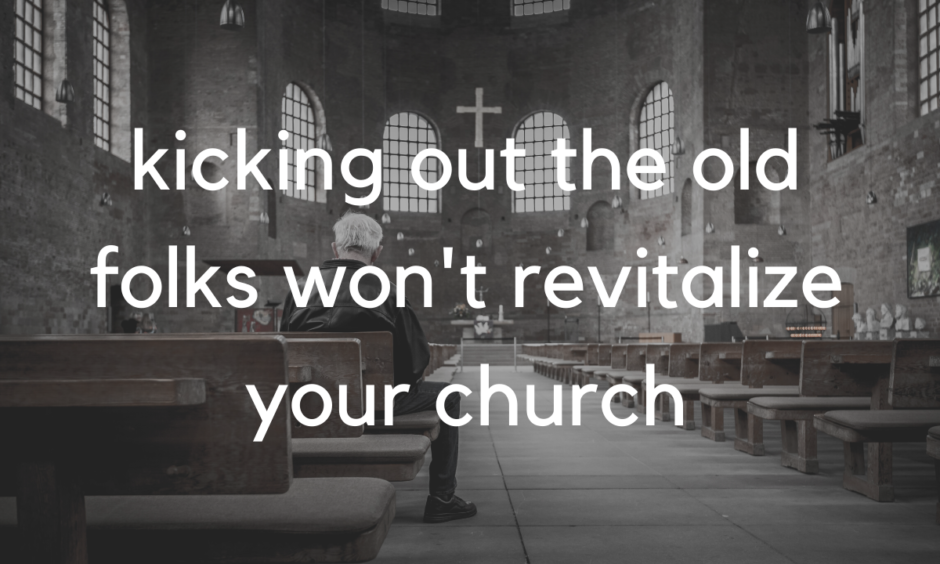A week and a half ago a church in the Twin Cities area made headlines – local and national – by supposedly asking its elder congregants to stop attending after the church relaunches later this year with the intention of reaching a younger demographic.. As with many situations, the reality of the details are a bit more nuanced than that. This report from CNN does a better job at giving a more balanced picture than most of the local news sources.
Regardless of the whole story – and it’s certainly more complicated than could be captured by any news report – it’s an interesting illustration of the challenge facing many churches today. As the CNN report concludes,
The relaunch — a process many Christian churches refer to as replanting — comes as the United Methodist Church denomination as a whole is aging. Baby boomers make up 38% of the church’s members, while millennials consist of just 13%, according to data from the Pew Research Center.
The denomination is struggling to hold on to younger members raised in the church and to attract new ones, a problem not specific to the United Methodist Church. Adults under 40 are less likely to identify with any religion than older adults, Pew data shows, and the age gap is most common in predominately Christian countries.
I passionately believe that the church is, as the Apostle Paul wrote so long ago, “[Christ’s] body, the fullness of him who fills all in all” (Eph. 1:23). God’s intention is for the body of Christ to be the primary means of proclaiming the Gospel and making disciples of Jesus.
I also passionately believe that those who are in the “young adult” stage of life are an absolutely crucial part of that body of Christ, and that the body suffers when it’s missing out on the vitality, creativity, faith, and boldness of 18-30 year olds. That’s why so much of my time is devoted to supporting church leaders in reaching and launching young adults into their Kingdom purpose with elementum.
All that to say I’m all for churches doing whatever they can to reach a younger demographic. But – and again, let me qualify what I write below by reiterating that I don’t know the ins and outs of the details of Cottage Grove UMC’s situation – a church relaunch won’t fix a broken system. And that’s assuming we set aside any questions about the orthodoxy of the UMC denomination’s theology.
The same thing, but younger
There are thousands of churches across the country wrestling with the same issues as Cottage Grove UMC: an aging and shrinking congregation, decreasing giving, and a seeming inability to attract new, younger congregants.
There are also thousands of churches across the country trying essentially the same thing as Cottage Grove UMC, though perhaps more tactfully and without as much news coverage. Bring in a younger pastor with preaching skills. Relaunch the church with a new, relevant mission statement. Leverage social media and technology. Make the worship and liturgy more modern. Maybe launch a few “community groups,” or if you’re really committed call them missional communities. Essentially, do all the same stuff but younger.
Doing all this without addressing inherent problems in the current church structure and systems will simply push the problem another 30 or 40 years into the future.
The same problems, but in the future
Let’s say Cottage Grove UMC and other churches following similar paths succeed spectacularly in their goals. They relaunch the church, attract new and younger faces (particularly those wily millenials and young families), increase giving, and enjoy a revitalized life as a church. That’s awesome. It will impact a new group of people with the Gospel and give them a church home and place to worship and belong. But odds are that’s about all it will do, and 30 years into the future once those young families have grown and their kids have moved on, those churches will be back in the same place, facing the same situation with a new generation.
Relaunching the church doesn’t address systemic problems within Christendom that have, as many missiologists and thinkers in the church world have already pointed out, led us to where we are today.
What are the problems?
From my own observation, reading, and thought I believe the following five things are the core of the problem facing churches like Cottage Grove UMC.
Problem 1: Lacking a whole-life Gospel that empowers everyone
The Apostle Peter makes the amazing declaration that all of God’s people are priests (1 Peter 2:5). Apostle Paul declares that we are all Christ’s ambassadors (2 Corinthians 5:20). In his Letter To the Christian Nobility of the German Nation the reformer Martin Luther states the biblical reality that every follower of Jesus is empowered and called to minister to each other and to the world.
Sadly this is far from the felt or practiced reality in most protestant churches. While it may be taught occasionally from the pulpit, most individuals in church congregations in America neither understand nor know how to live out the fact that they have been gifted and empowered by the Holy Spirit to build one another up. In fact many seem to simply have no understanding of the core truths of the Gospel, instead believing something more akin to what Christian Smith termed, “Moral Therapeutic Deism” – essentially do good to be a good person and make God happy. This lack of understanding the Gospel and the power given each born-again follower of Jesus is redoubled by second problem in this list – dependence on “professional” staff and church buildings – and training most church goers to be exactly that; attendees and consumers rather than passionate, empowered disciple-makers whose lives are powerfully shaped by the Gospel.
Regardless of the age of your congregation or how relevant your teaching, if they don’t grasp the significance of who they are in Christ and what they have been born again and called to do, your church will inevitably die.
Problem 2: Dependence upon a church building and paid staff
The head of Cottage Grove UMC, Rev. Dan Wetterstrom, wrote that “unless something changes, we are nearing the end,” in a memo to the congregation back in December. But an end of what?
Most likely (and this is simply my assumption based on my experience) what was meant was that unless the church grows and giving increases, we won’t be able to keep our building and have a paid pastor to preach and lead us on Sundays.
Sadly, for far too many Christians, a church without a building and a paid pastor isn’t a church. But where in God’s Word are those markers of a healthy, living church? Since when does not having a building mean a church is dead? Or to turn the thing on its head, since when does having a church building mean you actually have a living church? For the vast majority of Jesus-followers around the world and throughout history neither paid, seminary trained pastors nor a single-purpose meeting place are normal or necessary to be or do church.
Dependence upon a building and paid staff is one of the significant structural problems that plague the modern church in the west, and is a problem that will only get more acute as the culture turns increasingly away from Christian morals.
Problem 3: An inward focus
When a church is dependent upon building and staff and doesn’t know or know how to live out their Spirit-empowered Kingdom calling in day-to-day life it is inevitable that the church becomes inward focused.
The sinful, selfish bent of human nature makes us default to focusing on ourselves and those who comprise “us” rather than focusing on “them,” or those outside our current group. As a result, a congregation (or any group of people) without a clear vision that goes beyond themselves will become a closed system and eventually die out, most often destroying itself through nit-picking and internal conflict over things such as worship styles, interpersonal conflicts, and what color the sanctuary’s new carpet ought to be.
Problem 4: A lack of vision
To counteract that natural inward bent, leaders of any church – whether radically missional and without a building and staff or more traditional with building and staff – must help the congregation keep a clear vision of something bigger than themselves. Jesus does this for his disciples throughout his ministry, moving on from a specific place to preach elsewhere with the statement, “For this reason I have come…” and telling his followers multiple times that they are to go out into all the earth and proclaim the Gospel.
If the church doesn’t have a clear vision beyond itself – whether that be world missions or blessing the neighborhood they exist in or being a place for people to recover from addiction or any of the thousand other potential missional foci available to us – the church will eventually fade and die.
That’s why it’s crucial for pastors and church leaders to do more than just teach from a segment of scripture every week on Sunday morning. Instead we must disciple people into seeing the whole of life as Gospel-shaped and point the church as a whole towards a God-given purpose and vision.
Problem 5: Not knowing when to let something end
This is perhaps the hardest problem of all to state and to address in practice. The reality is that, like any other life on this earth, a church (I use the word church here meaning the distinct, organizational unit that we tend to consider “a local church”) isn’t meant to last forever.
Every organization has a life cycle, and while there are ways to revitalize and resuscitate a dying organization, there are times where a congregations shrinking and (in some cases literally) dying out may mean that it is time for an ending.
Jesus is King and head of the church. He’s the savior of our world, cities, and neighborhoods, not us and not our church. We need to be sensitive to the Spirit’s leading and be able to accept that there are times when a particular expression of the church needs to come to an end.
If Cottage Grove UMC’s doors shut it doesn’t mean God has failed at reaching the people of Cottage Grove with the Gospel. More than likely it is simply creating a space for God to send others to reach the city and neighborhood.
A different thing, and better
Each of those five problems are significant and the solutions are not easy. None of them are things that can be solved by a simple relaunch and asking the older generation in your congregation to step back from the church for a time.
What’s needed is the deep work of engaging with Scripture, culture, and our own hearts to identify the roots of idolatry that have led to systemic issues within the church at large, and then to do work of building something new on the solid foundations of the Gospel of Jesus Christ.
As I’ve already mentioned a couple times I don’t know the details of Cottage Grove UMC’s circumstances. But I do know that if a church has true passion and desire to reach young adults then one of the most effective, sustainable things they can do is try something different than the norm. Start by addressing the systemic problems mentioned above. Experiment. Move the church meetings into someone’s home. Young adults are drawn to the informal, communal feel that home meetings provide, and people who won’t set foot in a “church” will often happily sit down on someone’s couch. Train and empower all the believers to live and proclaim the Gospel in all of life, maybe by giving more stage time on a Sunday morning to “lay people” who can share stories of how God has impacted their everyday work, family, and community life. Cast a vision that goes beyond your church walls and then take dramatic steps to actually act on that mission. The church is worth it.





No Comments